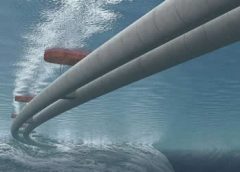By Mark S. Kuhar
In a world first, Norway is planning to build a submerged, floating tunnel to allow road traffic to cross one of its deepest fjords, according to an article in The Telegraph.
The tunnel will resemble two giant drinking straws, with each end anchored to the sides of the inlet, Sognefjord. The tubes, one for each direction of traffic, will be attached to floating pontoons spaced about 800 ft. apart.
The fjord has a depth of more than 4,000 ft., making it too deep for engineers to tunnel beneath it. Instead, the floating tunnel will be suspended about 100 ft. beneath the surface of the water. That will enable ships to easily pass over it, while there will be more than enough room beneath for the passage of submarines.
The unusual tunnel is part of an ambitious project to nearly halve the time it takes to drive one of the country’s main road arteries – the E39, a highway that runs for almost 700 miles from Trondheim in the far north to Kristiansand in the south.
At present, the highway is interrupted seven times, where drivers have to put their cars on ferries to cross fjords.
“It’s nearly 1,100 km from end to end – but the journey takes 21 hours on a good day, because of the seven ferry crossings en route. By 2035 we should have cut that to 11 hours by replacing the ferries with fixed crossings,” Kjersti Kvalheim Dunham, program manager for Norway’s Public Roads Administration, told a recent engineering festival.
In addition to the submerged tunnel, the Norwegians plan to dig a 17 mile-long tunnel beneath a 1,000 ft.-deep fjord.
The aim of the entire venture, which will cost $40 billion, is to make the export of goods easier and to encourage tourism along the country’s west coast.
The project is so complex that it will not be completed until 2050.

